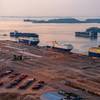IZAR Delivers For Stena
Departing from convention
In the upper deck access, the series differs from similar designs, having a single hoistable ramp on the port side located just forward of midships. Trucks which traverse the 5.9m wide internal ramp have to make two 180 degree turns before leaving the ship via the bow ramp. The internal ramp can be lifted into its stowed position with a 240t load. Two 25m-diameter turning areas have been laid out fore and aft on the upper deck, sufficient for the longest articulated vehicles. Apart from the supports surrounding the access casing on the portside, the upper deck is entirely free from pillars and obstructions. Accommodation Deck 7 is the main passenger entrance deck and has a large free-flow cafeteria and lounge. A separate drivers restaurant and lounge and a single business lounge are evidence of the anticipated dual use of the vessels. On deck 8, 87 two-berth cabins, 28 four-berth, two cabins for handicapped passengers, and two VIP cabins are provided, with a further 66 two-berth and six four-berth cabins on deck 9. A total of 25 crew cabins are located at the forward end of deck 9. A total of 13 officer's cabins are arranged to the port side on deck 10, with the air conditioning plant rooms on the starboard side.
Higher speeds
Reflecting the trend in RoRo vessels towards higher speeds, the sister vessels have a service speed of in excess of 20.5 knots and a trial speed of 22 knots at 90 percent MCR. The propulsion machinery is based on four main engines, each with an output of 5,760 kW (7,720 bhp) at 510 rpm. The combination of four main engines and twin CP propellers was selected as the most flexible option. The engines drive the propellers through twin-input/single-output gearboxes with power take-offs for 1,600 kVA shaft alternators. Three 870 kW gensets, driven by auxiliary engines, provide sufficient electricity for use in port, and when the twin 1,200 kW bowthrusters are in use. Together with the bow thrusters, a pair of flap rudders guarantee excellent maneuverability. The vessels are equipped with large surface-area fin stabilizers. An active anti-heeling system which has a pump capacity of 3,000 t/hr. is also installed.















